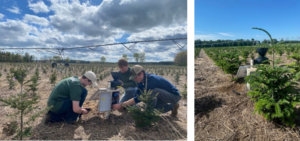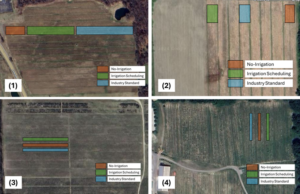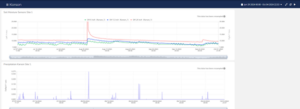Progress report for ONC24-145
Project Information
During the 2023 growing season, Michigan experienced significant drought conditions and erratic precipitation. Growers reported high rates of tree mortality on recently planted trees, especially under non-irrigated conditions. Young trees often have small, poorly developed root systems and are the most vulnerable to drought stress, resulting in tree mortality and poor growth. Irrigation has been shown to improve survivability and increase growth of young trees. However, excess irrigation wastes water resources, increases nutrient leaching and soil erosion, and promotes suitable environments for Phytophthora root rot, a significant pathogen leading to tree mortality. Proper irrigation management is critical to improve the sustainability of the Christmas tree industry amongst a changing climate. Often, growers use personal observations to schedule irrigation events. A commonly accepted viewpoint is irrigation events of 1 inch per week are sufficient in the absence of rainfall. However, there is limited evidence to support this value and determining the actual amounts of irrigation applied can be difficult. The goal of this project is to partner with 4 Christmas tree growers to demonstrate and evaluate the effects of irrigation management tools, including weather-based irrigation scheduling, soil moisture monitoring equipment, and automated irrigation control systems for use in Christmas tree production.
Objective 1: Train and familiarize Christmas tree growers with various irrigation tools such as weather-based irrigation scheduling, soil moisture sensor monitoring units, and automated irrigation systems.
Objective 2: Evaluate the effects of irrigation management tools in newly planted Christmas trees on survivability, irrigation water use efficiency, and Phytophthora root rot presence.
Objective 3: Share the results and grower’s experience of irrigation tools and technology with other Christmas tree growers through meetings (panel discussion) and publications.
Cooperators
Research
Objective 1 – Train and familiarize Christmas tree and nursery growers with various irrigation tools such as weather-based irrigation scheduling and soil moisture sensor monitoring units.
Four tree farms were selected for demonstration of weather-based irrigation scheduling and soil moisture monitoring equipment in 2024, with the support of the NCR-SARE program. Two farms use drip irrigation, and the other farms use a center pivot irrigation system. The demonstration farms are Badger Evergreen (Allegan, MI), Dutchman Tree Farm (Manson, MI), Korson Tree Farm (Sidney, MI), and Top Hill Farm (Goodrich, MI). In the 2024 growing season, Badger installed AgSense center pivot irrigation controlling system, and Korson installed a 9V solenoid valve controlling system to turn the irrigation on and off remotely. At Dutchman Tree Farm, the center pivot was already equipped with AgSense system. At Top Hill farm, the team decided to control irrigation using a manual valve because the farm uses a diesel water pump which requires manual operation. The project team installed LOCOMOS (Low-Cost Sensor Monitoring System) sensors on each demonstration farm. LOCOMOS sensors record in-field soil measurements (soil moisture level at 6, 12, and 24-inch depths, soil temperature) and environmental conditions (air temperature, relative humidity, and precipitation) and send the data to an IoT cloud webserver using an embedded cellular modem. Figure 1 shows photos of installed sensor monitoring systems.
Figure 1. Christmas tree irrigation demonstration farms. IoT-based soil and weather monitoring equipment were installed to monitor soil moisture levels, temperature, relative humidity, leaf wetness duration, and precipitation.
Objective 2 – Evaluate the effects of irrigation management tools on newly planted trees on survivability, irrigation water use efficiency, and Phytophthora root rot presence.
Each demonstration farm was divided into three sections to evaluate irrigation strategies (Figure 2). The strategies were grower’s existing irrigation strategy (applying 1 inch/week as a supplement), weather-based irrigation scheduling (rPET-based), and non-irrigation. Reference potential evapotranspiration (rPET) is the primary parameter in weather-based irrigation scheduling. In 2024, suction lysimeters were installed, but the team was not able to extract the water from the soil successfully. The issue was that the suction lysimeter did not hold the vacuum long enough, so the project team plans to use other type of suction lysimeters in 2025. Tree growth and survivability will be monitored in early 2025.
Figure 2. Irrigation demonstration plots: (1) Badger Evergreen, (2) Dutchman Tree Farm, (3) Korson Tree Farm, and (4) Top Hill Farm.
In year 1, the project team focused on collaborating with growers to install and train the operation of automatic irrigation systems. In addition, IoT-based soil moisture sensor data website was shared with growers. Figure 1 shows an IoT (Internet of Things) website of the one of on-farm demonstration sites. In 2024, We discussed how to access and interpret the collected data.
Figure 1. An IoT website that display real-time soil moisture sensor data at 6, 12, and 24 inch depth and precipitation.
The irrigation strategy evaluation was initiated in year 1, however the tree growth, trunk diameter, and survivability will be measured in April or May 2025. This is because the nature of tree growth is slower than other crop types.
Educational & Outreach Activities
Participation Summary:
The team gave a talk regarding sensor technology for irrigation management at Michigan Seedling Grower Association summer meeting, which was held in Allegan, MI on 8/29/24. PI Dong also recorded a presentation on irrigation management for Christmas Tree production, which will be shared with nursery and Christmas tree growers in 2025. In addition, the PI Dong gave a presentation at MSU Christmas Tree Webinar Series in Feburary 2025, attracted more than 200 growers and ag professionals from across U.S.
Learning Outcomes
Using soil moisture sensors for irrigation management
Evapotranspiration-based Irrigation Management for Christmas Tree Production
Irrigation Scheduling Smartphone App
Project Outcomes
This project is ongoing and couple years of data collection is needed to truly evaluate the effectiveness of irrigation management on Christmas Tree.
Irrigation scheduling helps Christmas Tree growers make better informed decisions about when and how much to irrigate, which will improve irrigation water use efficiency and increase ii, while minimizing drought stress and the risk of root disease. The information derived from this study supports 657 Christmas tree farms in the North Central region. According to USDA survey, 3.3 million Christmas trees were sold in 2019 in the North Central region, with a sales value of $85.5 million. As states in the North Central region have experienced climate change with variable temperature, drought, and erratic precipitation, irrigation plays an important role in newly planted Christmas trees to be resilient to climate change.


